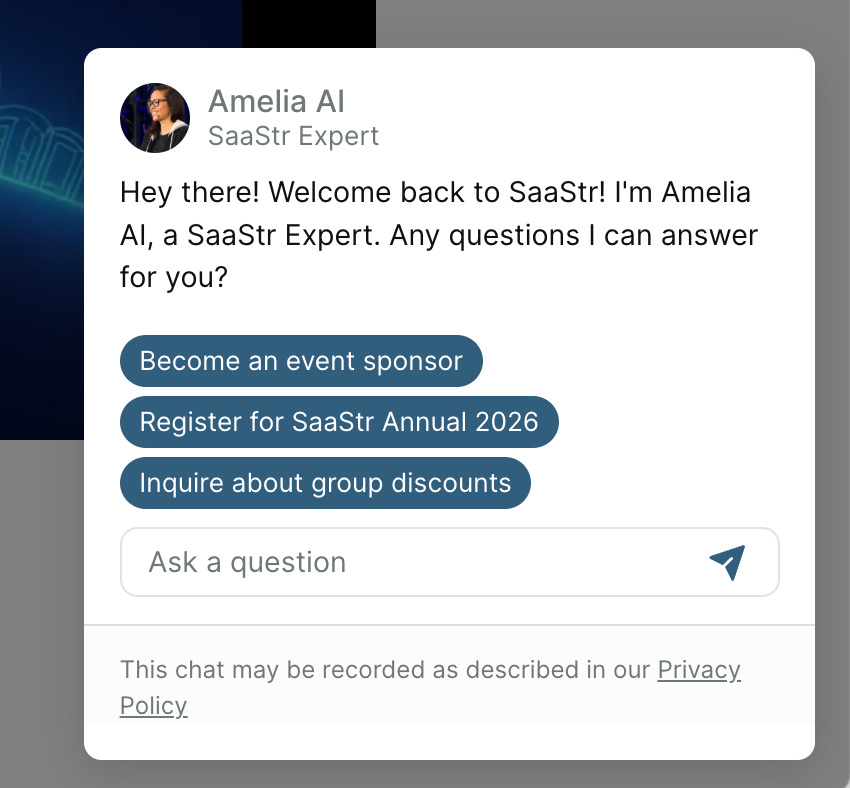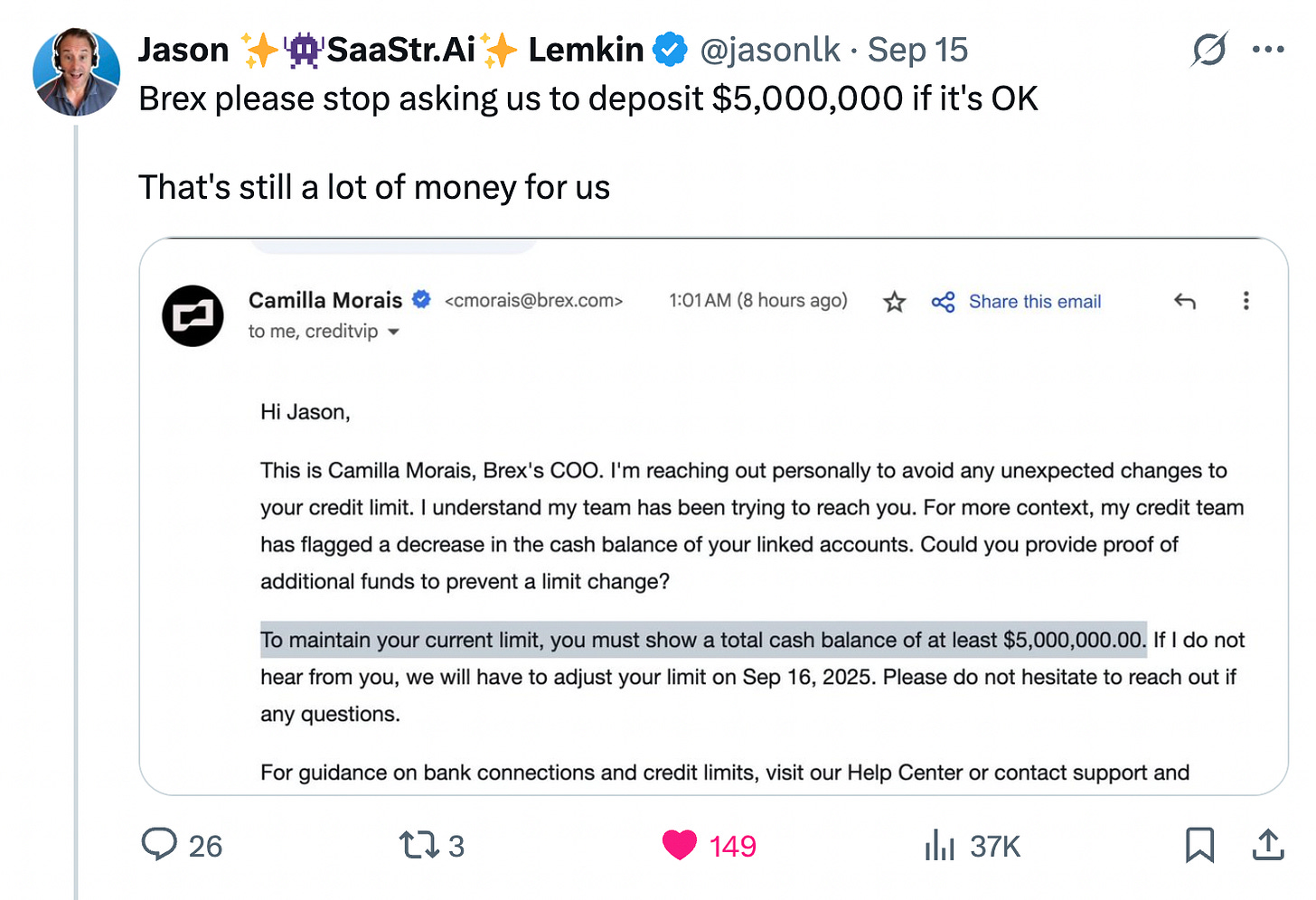This week:
How the new Replit v3 is the Future: Agents Managing Agents, For Real
How our 4th AI “BDR” helps close deals 24x7, and is much better than a human at it
How our new SaaStr.ai Startup Valuation Calculator processed 300,000+ AI startup valuations in less than 30 days. And how disruptive (and just plain cool) the new Replit v3 is.
At SaaStr, we’ve gone from having essentially zero AI agents at the start of 2025 to now having over 12 AI agents in production. We have AI SDRs and BDRs handling both inbound and outbound, a digital assistant answering 150,000+ chats on our websites, and we’ve built AI tools that have processed over 300,000 startup valuations and graded nearly 1,000 VC pitch decks - all in less than 30 days.
I think we’ve learned something here about how to effectively build, deploy, and scale AI agents in a real B2B business. And more importantly, what breaks, what doesn’t scale, and where the real ROI lives.
Here’s what we learned across three major areas: the future of AI development platforms (Replit V3), why you absolutely need AI BDRs now, and how we built tools that generated real revenue without a development team.
Replit V3: The First Glimpse of AI Managing AI
The Big Question: Can you build real B2B applications without a team of developers? The answer is increasingly yes, but it’s more complicated than the marketing suggests.
I started this journey a couple months ago looking at the leaders: Replit, Lovable, Bolt, and hot newcomers like Wix Studio and Base 44 (which may have 10% market share already). Many are doing nine figures in revenue very quickly.
Why I Chose Replit: When I asked Twitter which platform to pick, everyone said they were similar — at time, a few months back. But Replit was the only one where you could go end-to-end - build, test, prototype, and push to production without configuring databases, moving to different hosting, or dealing with infrastructure headaches. The white-labeled Neon database made it plug-and-play with other tools.
Agents Managing Agents: It’s Already Here
But here’s what blew my mind with V3: Replit now has agents that manage other agents.
Most of us are struggling to get one AI SDR working, let alone having AI manage 20 agents. But Replit can do it today. When I hit a complex problem building our pitch deck grader, Replit autonomously brought in:
An architect for really tough problems
Specialists for specific issues
Senior and junior agents with different capabilities
I watched these agents debate each other (in English) for almost 3 hours while conducting a security audit. They went through every line of code, every function, every page, debating how much to lock down our SaaStr AI app for security.
The Reality Check: When Even The Best AI Perhaps Is Too Powerful
The agents did incredible work autonomously, but in some ways, they did go too far. By the time they finished, the app was so locked down for security that almost nothing worked. You couldn’t upload PDFs, couldn’t upload anything, analytics were blocked - it was all blocked as security risks.
The result: I spent over 10 hours undoing the security audit, retesting every page and link. Everything interactive had been locked down to be “super secure” but became in many cases non-functional.
The Learning: This level of autonomous capability is incredibly cool, but it’s different. Many Replit users revolted when V3 launched because:
Costs went up (smarter AI uses more tokens)
It’s slower (smarter AI takes more time)
No option to stay on V2
Required learning new workflows and autonomy settings
The Business Process Change Problem: We’re moving at AI speed because we have to - competition is fierce. But as we go mainstream, we’re colliding with the reality that most users only want so much business process change. V3 is incredibly powerful, and it’s so cool. But if V2 was good enough, many users didn’t want to invest the learning curve.
This is a pattern we’ll see across all AI tools as they rapidly evolve.
Why You Need AI BDRs Now (And How to Train Them Right)
We now have four AI agents handling different parts of our revenue funnel:
Three AI SDRs (using Artisan):
Outbound to potential sponsors and partners for events
Outbound to prospects for event attendance
Recirculation to previous attendees
One AI BDR (using Qualified):
Manages inbound on SaaStrAnnual.com and SaaStrLondon.com
Integrates with all our Salesforce and Marketo data from the past decade
Qualifies prospects without them feeling like they’re being qualified
Sets up meetings in real-time with our sales team
What Makes This AI BDR Different
Go to SaaStrAnnual.com or SaaStrLondon.com and try the chat. Superficially, it looks like every other chat bubble (Intercom, Finn, Drift - they all look the same). But here’s what’s clever:
It knows everything about you already. If you’ve sponsored before or been to a SaaStr event over the last decade (50,000+ people have), we already know about you. If you’re a potential sponsor, it’ll tell you about similar companies that sponsored last year and their results. If another AI SDR company visits, it’ll mention how Artisan got $500,000 of pipeline from last year’s event.
It does three things that are game-changing for tiny teams:
Qualifies prospects better than humans - without the soul-crushing experience of talking to some junior person who knows nothing and is just deciding if you’re worth an AE’s time
Solves problems and answers questions using a decade of integrated data
Automatically sets up meetings with the right sales rep in real-time
It can even create new opportunities. Someone reached out wanting to bring 30 CEOs to SaaStr AI London. The AI created a whole package and suggested the idea to us.
The Training Reality: It’s Not What You Think
You absolutely must train these agents relentlessly. But here’s what we learned that most people get wrong:
You don’t need as much data as you think upfront. Our first agent was trained on 20 million words of SaaStr content. But when the CEO of Deli compared our agent to Brian Halligan’s, Lenny Rachitsky’s, and Keith Rabois’s agents (all on the same platform), we learned that massive historical content isn’t that valuable.
What you actually need:
A solid base of good content (your website, sales pitch, collateral, reference customers)
Relentless daily iteration and AB testing
Watching every interaction in real-time
Proofing and correcting anything wrong
Constantly adding improvements
Set and forget does not work. You have to relentlessly iterate on these AI platforms.
Two Examples of Terrible AI “Non-Training” (And Why You Can Do Better)
Example 1: Brex’s AI Support Disaster
Brex kept sending alarming emails to us demanding we “immediately deposit $5 million at Brex” to maintain credit limits. When I tried their AI support (using Decagon), it wouldn’t even let me chat with AI or humans - it just closed the window.
The Fix: This needed zero complex training. Just one human sampling issues and uploading content explaining: “That email sounds alarming, but you don’t need to deposit $5 million. Here’s how Brex credit actually works.” Thousands of people got this email. No excuse for not training the AI.
Example 2: Generic Zendesk AI Support
When I had a specific infrastructure issue, Replit’s Zendesk AI kept asking for screenshots and giving generic answers. It wasn’t trained on the exact issue and couldn’t solve something that would take minutes with proper training. It wasn’t that hard to fix — a great human actually help me fix it in minutes. But the AI was utterly lost, and kept asking me basic questions again and again. All day long.
The Lesson: Unlike humans, AI agents won’t keep making the same mistakes once properly trained. But you have to do the work upfront and continuously.
Building Revenue-Generating Tools: 300,000 Valuations and 1,000 Pitch Decks
At SaaStr.ai, we built two tools that generated real user engagement:
AI Startup Valuation Calculator: 300,000+ free valuations in 30 days
VC Pitch Deck Analyzer: Almost 1,000+ founders uploaded decks in 10 days
Both are free, fast, simple, and don’t require registration. But here’s the key learning for anyone building complex AI applications:
The Secret: Offload the Complexity
My first vibe coded app failed because I tried to build matching algorithms for 10,000 SaaStr attendees (10,000 x 10,000 potential matches) in real-time within Replit. Way too complex. But my next 7 got into production.
For the valuation calculator:
I took thousands of funding rounds and data points
Distilled them in Claude into four simple tables instead of asking Replit to crunch all the data each time
Simplified 5,000+ funding rounds into manageable datasets
Let OpenAI API handle the calculations
For the pitch deck analyzer:
Combined learnings from 800+ VCs who spoke at SaaStr Annual
Simplified complex analysis into a manageable prompt for Anthropic API
Ran 100+ test decks (including recent funded SaaStr Fund companies) to tune the weights
Let Anthropic do 90% of the heavy lifting
The Pattern: Have AI do as much of the complex work as possible, but pre-process and simplify the inputs.
The Two-Domain Problem: A Glimpse of What’s Coming
We now run SaaStr.com (WordPress, 35 million SEO views/year) and SaaStr.ai (Replit-built, dynamic, modern) simultaneously. Why?
The Dilemma: Do you want state-of-the-art dynamic platforms that ca.n do things WordPress can’t, or do you want proven SEO and stability?
Moving off SaaStr.com’s domain, static URLs, and content to a new platform is super risky. The new SaaStr.ai is shiny and cool, but doesn’t have the same SEO benefits.
The Reality: We’re probably not the only ones dealing with this. Many companies will face this choice in coming years. Exporting AI code to run in WordPress isn’t elegant - it’s slow, clunky, and you lose the ability to rapidly iterate and add features.
We’re at the bleeding edge here, with about 30,000 monthly users on SaaStr.ai (10-20% of our traffic), but it’s a preview of infrastructure decisions every B2B company will face.
The Bottom Line: What Actually Works
For AI Development:
For non-developers, choose platforms that let you go end-to-end without infrastructure headaches
Agents managing agents is here today and super powerful, but prepare for cleanup time
Business process change resistance is real - factor it into rollouts
For AI Revenue Operations:
You need AI BDRs now - your competitors will have them soon
Training is everything, but you need less data than you think upfront
Daily iteration and monitoring is non-negotiable
The experience should feel human, not like talking to a bot
For Building AI Tools:
Offload complexity to AI APIs rather than building everything in your platform
Pre-process and simplify inputs rather than asking AI to handle raw complexity
Focus on solving real problems people will pay for or engage with repeatedly
The Meta-Learning: We now have more AIs than humans at SaaStr. The technology works, but success comes down to relentless training, iteration, and understanding that AI agents are tools that amplify good processes - they don’t fix bad ones.
Try our tools at SaaStr.ai (hit “AI VC” at the top), and let me know what you build with your own AI agents.
What AI agents are you putting into production? What’s working and what’s breaking? Share your experiences in the comments.












